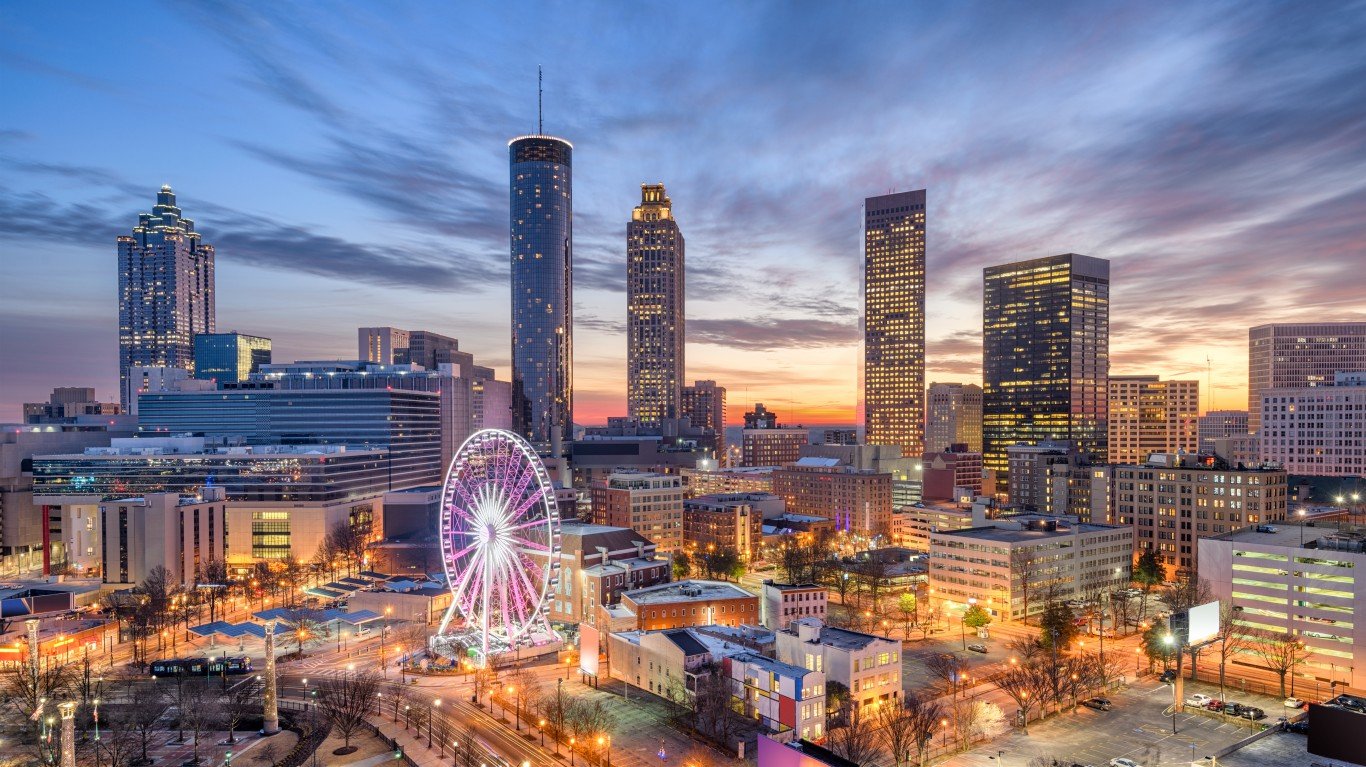

There are an estimated 39.5 million Americans living below the poverty line, which, in the lower 48 states, is an annual income threshold of $12,880 for an individual and $26,500 for a family of four (Alaska and Hawaii have a slightly higher threshold). Living in poverty can have serious consequences and impacts nearly every aspect of life — and those problems can be compounded for those who are facing poverty while also living in very poor neighborhoods.
Residents of poor neighborhoods often struggle with higher crime rates, limited employment opportunities, lower school quality, and poor health outcomes. For those living on poverty level income, each of these factors reduces the likelihood of upward economic mobility.
Albany has the highest concentrated poverty rate of any metro area in Georgia and one of the highest of any metro area nationwide. There are nine neighborhoods in the city with poverty rates of 40% and up — and they are home to over one-third of the 34,600 people in the metro area living below the poverty line.
Many living in Albany’s high-poverty neighborhoods face barriers to economic opportunity due to low educational attainment. For example, less than three-quarters of adults in neighborhoods with poverty rates of 40% or higher have a high school diploma compared to about 87% of adults in the rest of the city. Additionally, the share of adults with a four-year college education in Albany is more than double the share of adults with such a degree living in the city’s concentrated poverty neighborhoods.
All data used in this story are five-year estimates from the U.S. Census Bureau’s 2019 American Community Survey. We only considered census tracts, or neighborhoods, with at least 500 people and college or graduate school enrollment below 50%. Metro areas were also excluded if over 25% of the population in tracts or neighborhoods of concentrated poverty were college or university students.
| Metro area with worst extreme poverty | Poor residents in high-poverty neighborhoods | Overall poverty rate | Overall poverty rate, statewide |
|---|---|---|---|
| Alabama: Tuscaloosa | 16.7% | 18.2% | 16.7% |
| Alaska: None | N/A | N/A | 10.7% |
| Arizona: Phoenix | 9.9% | 13.6% | 15.1% |
| Arkansas: Little Rock | 7.8% | 15.0% | 17.0% |
| California: Fresno | 28.5% | 22.5% | 13.4% |
| Colorado: Pueblo | 5.9% | 18.8% | 10.3% |
| Connecticut: New Haven | 12.7% | 11.7% | 9.9% |
| Delaware: None | N/A | N/A | 11.8% |
| Florida: Tallahassee | 21.5% | 15.8% | 14.0% |
| Georgia: Albany | 35.3% | 24.2% | 15.1% |
| Hawaii: None | N/A | N/A | 9.4% |
| Idaho: None | N/A | N/A | 13.1% |
| Illinois: Danville | 20.6% | 18.9% | 12.5% |
| Indiana: Muncie | 18.7% | 17.2% | 13.4% |
| Iowa: Waterloo | 9.6% | 13.4% | 11.5% |
| Kansas: Wichita | 5.7% | 13.0% | 12.0% |
| Kentucky: Louisville | 11.2% | 12.3% | 17.3% |
| Louisiana: Monroe | 49.5% | 24.2% | 19.2% |
| Maine: Lewiston | 13.5% | 11.8% | 11.8% |
| Maryland: Baltimore | 9.3% | 10.0% | 9.2% |
| Massachusetts: Springfield | 23.4% | 14.8% | 10.3% |
| Michigan: Flint | 32.4% | 18.9% | 14.4% |
| Minnesota: Duluth | 7.9% | 13.0% | 9.7% |
| Mississippi: Jackson | 21.3% | 16.9% | 20.3% |
| Missouri: Cape Girardeau | 27.9% | 16.4% | 13.7% |
| Montana: Great Falls | 19.8% | 13.3% | 13.1% |
| Nebraska: Omaha | 3.8% | 10.3% | 11.1% |
| Nevada: Las Vegas | 5.1% | 13.7% | 13.1% |
| New Hampshire: Manchester | 2.9% | 7.8% | 7.6% |
| New Jersey: Trenton | 21.3% | 11.7% | 10.0% |
| New Mexico: Las Cruces | 26.1% | 26.3% | 19.1% |
| New York: Buffalo | 27.4% | 14.0% | 14.1% |
| North Carolina: Goldsboro | 12.5% | 20.2% | 14.7% |
| North Dakota: None | N/A | N/A | 10.7% |
| Ohio: Toledo | 26.0% | 16.0% | 14.0% |
| Oklahoma: Oklahoma City | 9.2% | 13.7% | 15.7% |
| Oregon: Medford | 2.3% | 15.5% | 13.2% |
| Pennsylvania: Reading | 28.8% | 12.0% | 12.4% |
| Rhode Island: Providence | 4.0% | 12.0% | 12.4% |
| South Carolina: Columbia | 7.9% | 14.4% | 15.2% |
| South Dakota: None | N/A | N/A | 13.1% |
| Tennessee: Memphis | 24.6% | 17.5% | 15.2% |
| Texas: Laredo | 46.4% | 27.5% | 14.7% |
| Utah: None | N/A | N/A | 9.8% |
| Vermont: None | N/A | N/A | 10.9% |
| Virginia: Roanoke | 15.9% | 12.9% | 10.6% |
| Washington: Yakima | 8.5% | 17.4% | 10.8% |
| West Virginia: Huntington | 14.8% | 18.8% | 17.6% |
| Wisconsin: Milwaukee | 17.4% | 13.1% | 11.3% |
| Wyoming: None | N/A | N/A | 11.0% |
Take This Retirement Quiz To Get Matched With A Financial Advisor (Sponsored)
Take the quiz below to get matched with a financial advisor today.
Each advisor has been vetted by SmartAsset and is held to a fiduciary standard to act in your best interests.
Here’s how it works:
1. Answer SmartAsset advisor match quiz
2. Review your pre-screened matches at your leisure. Check out the advisors’ profiles.
3. Speak with advisors at no cost to you. Have an introductory call on the phone or introduction in person and choose whom to work with in the future
Take the retirement quiz right here.
Thank you for reading! Have some feedback for us?
Contact the 24/7 Wall St. editorial team.

